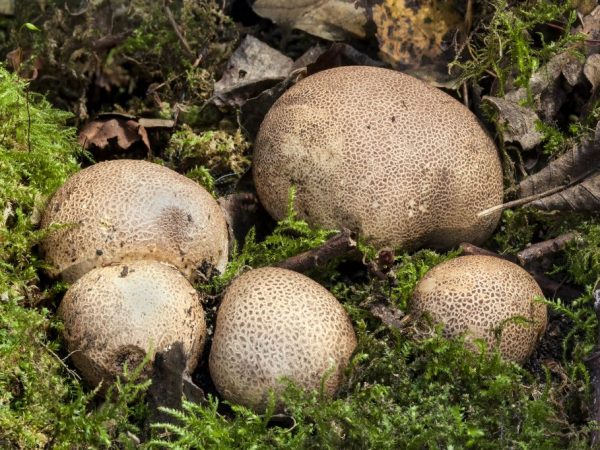Common pseudo-raincoat
Common pseudo-raincoat is an interesting mushroom, a representative of the Scleroderma family, or Pseudo-raincoats.

Common pseudo-raincoat
Botanical characteristic
According to the botanical description, the common false puffball belongs to the polyphyletic group of gasteromycetes from the Basidiomycete class, it has a very special structure of the fruit body, which can open when ripe or remain completely closed.
Other names for pseudo-raincoat are scleroderma vulgaris and pseudo-raincoat lemon.
In this fungus, the fruiting body can be of several forms: tuberous, ovoid or spherical flattened, reniform at the cut site. It resembles a potato in appearance. In the lower part, the fruit body is slightly narrowed, consists of tapered mycelium fibers, often wrinkled. The diameter of the mushroom is from 3 to 12 cm, the length is 3-6 cm. The mushroom leg is absent.
The fungus shell (peridium) consists of one layer 2 to 4 mm thick. The structure is dense, leathery, scaly or covered with warts. The color of the peridium is brown, yellow with ocher; when cut, it turns red. As it ripens, the mushroom shell breaks in different directions.
The yellow tint is given by the pigment substance sclerocytrin contained in the chemical composition.
The pulp (gleb) in young specimens is yellow-white. As it grows up, it acquires a dark shade - it becomes either purple up to black or completely black with white veins. The structure of the mushroom pulp retains its density for a long time until, after the final ripening, it breaks down into gray-yellow fragments and an olive-colored spore powder.
Irina Selyutina (Biologist):
Mature olive-gray gleb with whitish veins, i.e. with a marble pattern on the cut - is a distinctive feature of the real raincoats belonging to the genus Lycoperdon.
Young specimens have a distinct spicy smell, similar in description to potato. The taste is not pronounced.
The pseudo-raincoat mushroom is inedible.
Geography of distribution
Common pseudo-raincoat is the most common species among the entire genus, numbering more than 60 species. On the territory of Russia, it is found in the European part, in the North Caucasian regions and in the Far Eastern regions. Grows in small colonies and singly. Able to withstand prolonged drought.

The fungus grows in small colonies
The beginning of the fruiting period of the mushroom false raincoat falls in July and lasts until the middle of the autumn season.
He prefers soil as a habitat for rotten wood, choosing illuminated areas in forests (places where deciduous and coniferous trees grow), meadow glades, fields and forest edges. It is widespread in heather wastelands (heaths) depleted in potassium, nitrogen and phosphorus, near the roadbed and near young plantings. Selects dry sandstones and pebble soils, grows among mosses and sparse grasses.
Advice. If you have not had to collect raincoats before, it is better not to take risks and not touch the mushrooms:
- growing nests;
- equipped with long false legs;
- with an obvious yellow or brown skin, which is also covered with rough growths and noticeable cracks;
- having an unpleasant odor.
Similar varieties
The common false raincoat has similar varieties:
- Bulbous raincoat: is distinguished by an areolated mushroom shell and a prickly spore powder without a reticular pattern on the surface inherent in the species L. ordinary;
- Warty pseudo-raincoat: has a long false stem and grows in other areas, preferring dry sandy soils of forests, gardens or parks;
- False raincoat spotted: differs in smaller size and thinner, up to 1 mm, mushroom shell with scales, as well as a long false stem.
Gastronomic qualities
The inedible lemon false raincoat is not applicable for gastronomic purposes. When used in large doses, it causes mild poisoning, which results in pronounced disorders in the work of the gastrointestinal tract, for example, painful stomach cramps, as well as dizziness. Allergic reactions caused by fungal spore powder, which manifest themselves in the form of inflammatory processes of the conjunctiva and the nasal mucosa, have been recorded.
Irina Selyutina (Biologist):
The famous Russian mycologist A. A. Yachevsky (1863–1932) pointed out that pseudo-raincoats at a young age before the ripening of spores were often used to counterfeit truffles, although they had nothing to do with either botanical or culinary aspects.
In small quantities, young, non-overgrown specimens are acceptable for food use and are added as an ingredient in culinary dishes, because have a taste and smell similar to truffles.
Conclusion
Lemon raincoat belongs to the Scleroderma family. It is found on the territory of Russia, being the most common species among pseudo-raincoats. A raincoat is considered poisonous, but in small quantities it is permissible in the preparation of a number of dishes to impart a taste and smell similar to truffle.



